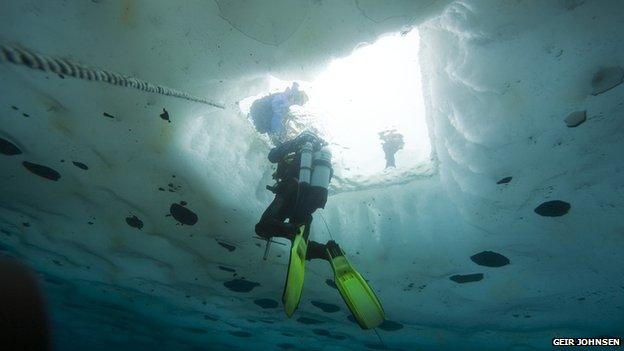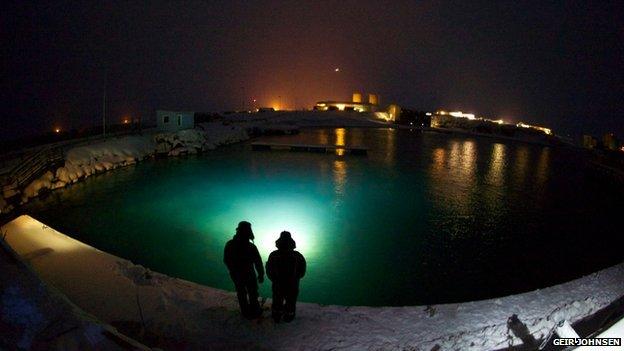New Arctic research projects start
- Published

Professor Jørgen Berge, Arctic ABC's project leader, surfaces after observing marine life under sea ice
The Scottish Association for Marine Science (Sams) has announced the start of two research projects worth £4.7m.
The Oban-based Sams will be a partner in Norwegian-led studies investigating changes in Arctic ecosystems.
Arctic ABC will investigate how the Arctic is responding to the loss of sea ice, whilst FAABulous will focus on changes in Arctic algae.
Sams has previously been involved in pioneering research involving the little-studied polar night.
Arctic ABC was launched in Oban during a recent Arctic conference at Sams, which welcomed 40 delegates from the UK, Norway, USA, Russia, Germany and Denmark.
This project aims to understand the ecological consequences of the melting of the Arctic sea ice by observing what goes on underneath sea ice in the polar night, and will draws on Sams' experience in the areas of robotic technologies, sea ice physics, polar oceanography and ecology.

Opening Pandora's box
Arctic ABC follows on from ongoing pieces of research involving the polar night - when there is continuous darkness 24 hours a day, a phenomenon that only happens in Arctic regions north of the polar circles.
The polar night is as yet little-studied, due to difficulties in access and working conditions, but Dr Cottier said that their work had suggested there was more life and activity there than previously thought.
The research looked into how the moon triggers mass migration behaviours in zooplankton during the polar night, and the subsequent impact that has on the ecosystem and fisheries there.
Zooplankton behaviour in more normal conditions is dictated by the sun - in the daylight, they tend to go to lower depths to avoid being eaten, whereas at night they come to the surface to feed. The project found that during the polar night, the zooplankton switch to a lunar cycle rather than a solar one.
Professor Jørgen Berge of the Arctic University of Norway, who is leading Arctic ABC, said: "80 degrees north of Svalbard the polar night becomes pitch black. It's a black box no-one has properly looked into but we opened a Pandora's box; everything was a discovery of the polar night."

Dr Finlo Cottier, organiser of the conference, said he understood that some people might find it strange that a lab based on the west coast of Scotland was so deeply involved in Arctic research.
But he said Sams had a long history in the field, dating back to the late 19th Century.
Before one of his Arctic expeditions, Fridtjof Nansen, the great Norwegian explorer, came to do a marine biology field course at the association, which was called the Royal Scottish Marine Station at the time.

Ny-Ålesund, a research town in Svalbard, Norway
A recent House of Lords Arctic Committee report highlighted the UK government's 2013 Arctic Policy Framework as "too hesitant and cautious," and recommended the UK becomes more effective in "communicating its connections to the Arctic and its strengths in knowledge, skills and businesses with relevance to the Arctic."
But Dr Cottier believes although visibility of research might be quite low due to it being done in "small pockets", when the work is packaged together, there is a "tremendous amount" being done in the UK on the Arctic.
Prof Asgeir Sørensen, director of Norway's Centre for Autonomous Marine Operations and Systems (AMOS), who is also involved with the projects, said that the involvement and co-operation of British institutions in research campaigns was vital for the future.
"It is extremely important that the UK and Norway work together and our partnership working with Sams, in particular, is extremely exciting and stimulating," he said.
"The Arctic is one of the most undiscovered areas of the planet and that curiosity is driving us to work together, not separately."